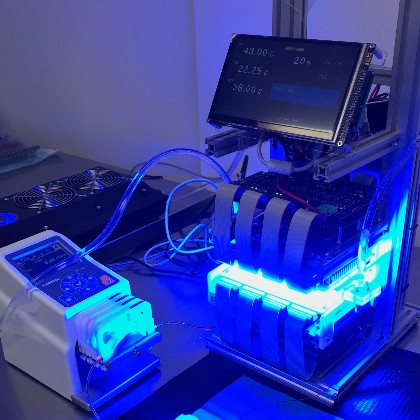Researchers at Oregon State University College of Engineering have developed a microfluidic photoreactor designed to treat severe cases of neonatal jaundice. Jaundice is caused by an excess of a pigment called bilirubin, which in many newborns can be difficult to pass due to underlying medical conditions. In severe cases, newborns may require multiple blood transfusions, which is resource and labor intensive and can be risky. This system could help avoid such procedures and involves passing the newborn’s blood through a microfluidic device in which an LED helps break down the bilirubin into more easily eliminated substances.
Newborn jaundice is relatively common, and the majority of babies will be fine with little or minimal treatment. However, in severe cases, the condition can cause neurological damage and even death. In such severe cases, doctors treat the condition by replacing newborn blood with donor blood. However, it is necessary to do the transfusion procedure twice, which makes it time consuming and a little risky.
To create a safer, more convenient alternative, these researchers created a device that can break down bilirubin, the dye in the blood that is responsible for jaundice. In this technique, the patient’s blood is passed through a microfluidic device that contains a high-intensity LED that causes the bilirubin to break down into more excretable components.
The technique is similar to another method used to treat jaundice called full body phototherapy, which involves applying light to the skin. However, because the new technology illuminates the blood directly, it is more targeted and efficient. So far, the researchers have tested the photoreactor with bilirubin-rich human blood on the laboratory bench and in a rat model.
“The results show that high-intensity light with a wavelength of 470 nanometers can be used to lower bilirubin levels quickly without causing any significant damage to blood cell DNA,” said Adam Higgins, a researcher involved in the study, in a press release . “Our work with Gunn rats has shown that a four hour photoreactor treatment significantly reduces bilirubin levels – similar to the type of bilirubin reduction seen in exchange transfusions and over a similar period of time. The mathematical model we developed suggests that this new treatment approach, which we tested on a laboratory scale, outperforms an exchange transfusion on a clinical scale and does not require donated blood. “
The researchers plan to scale the photoreactor so that it can be used on human patients. “But overall, it looks like advancement in photoreactor technology could offer a promising new approach to treating extremely high levels of bilirubin in the blood of newborns,” said Higgins.
Study of biomicrofluidics: Microfluidic photoreactor for the treatment of jaundice in newborns
Above: Oregon State University
